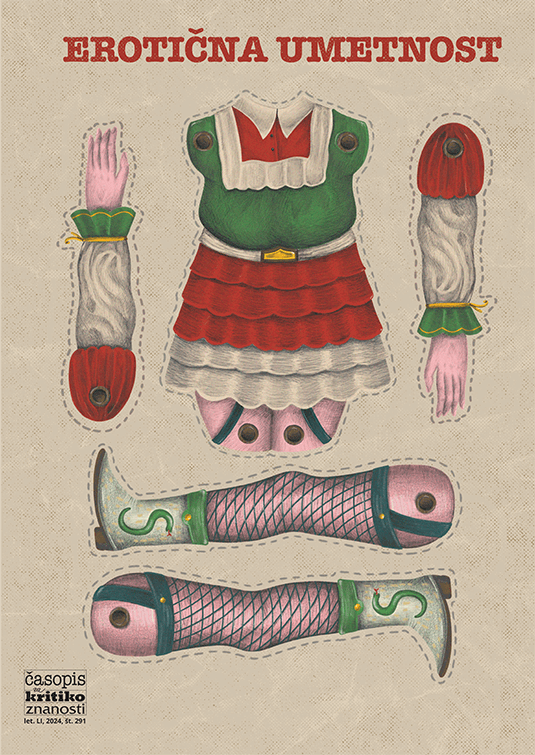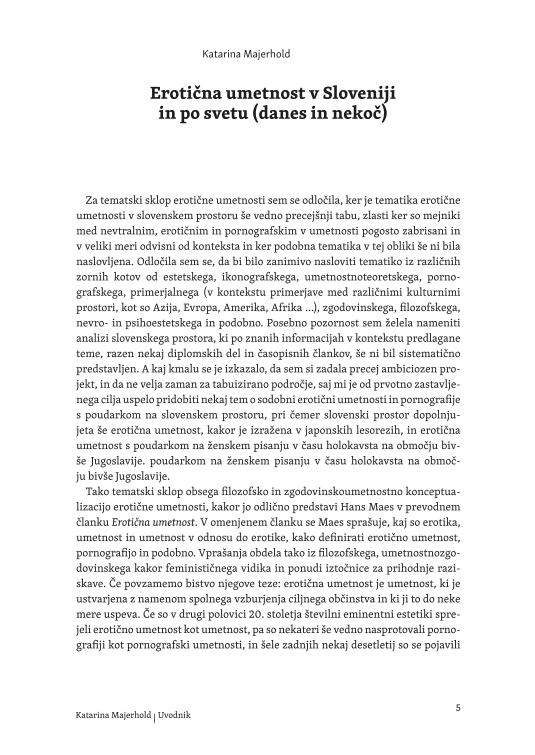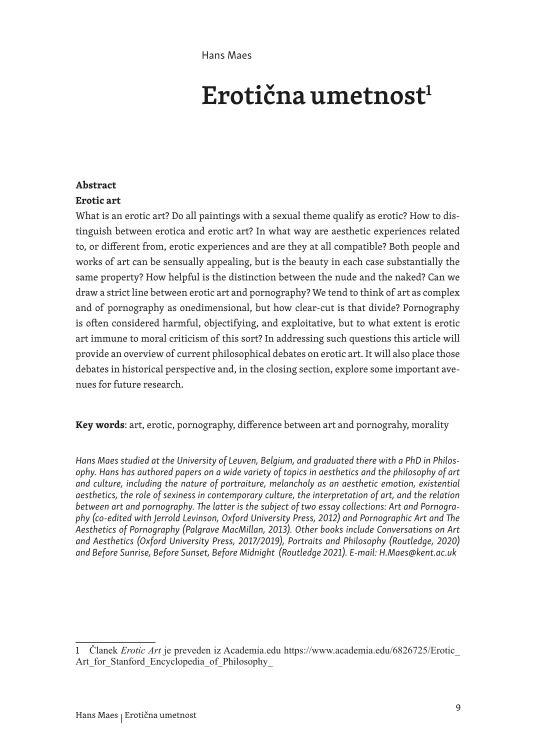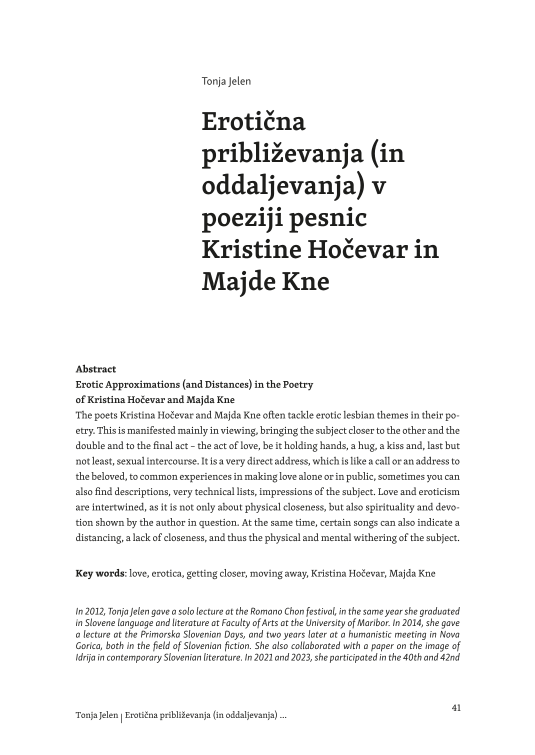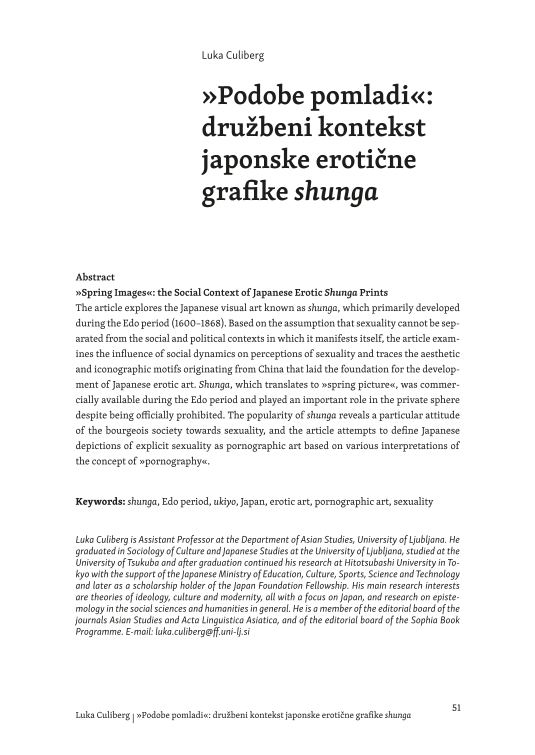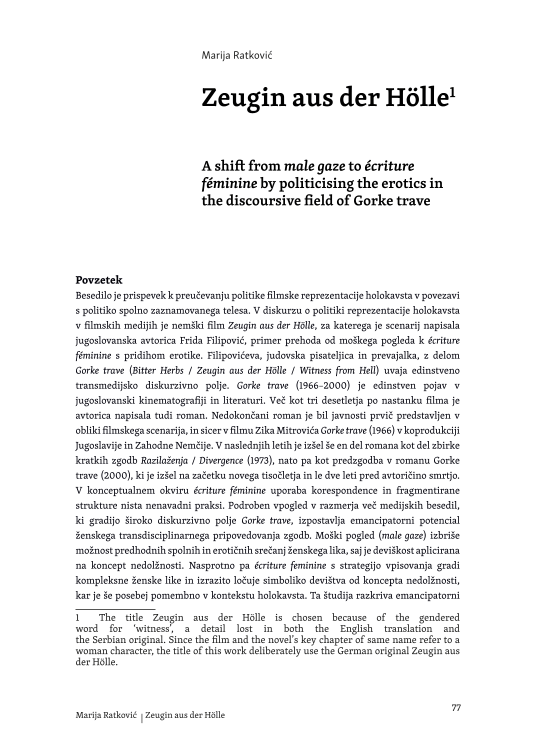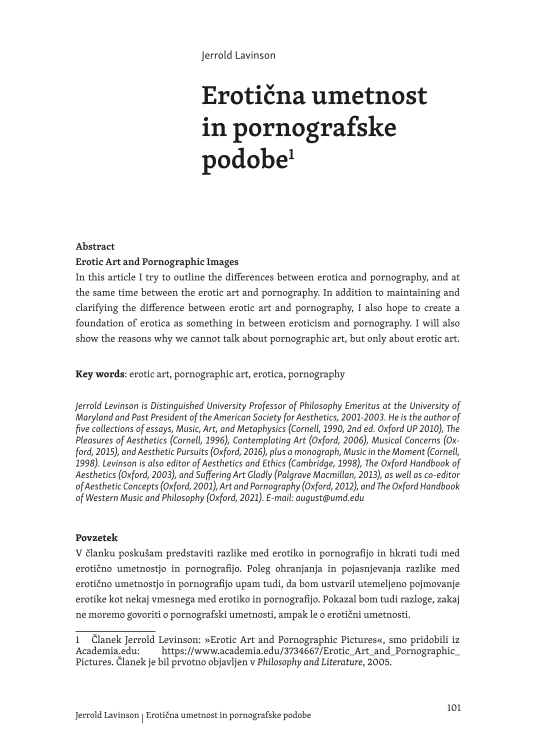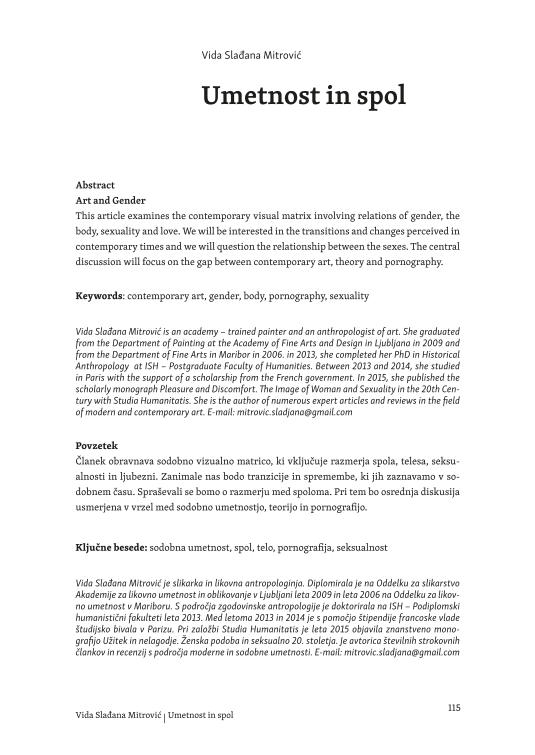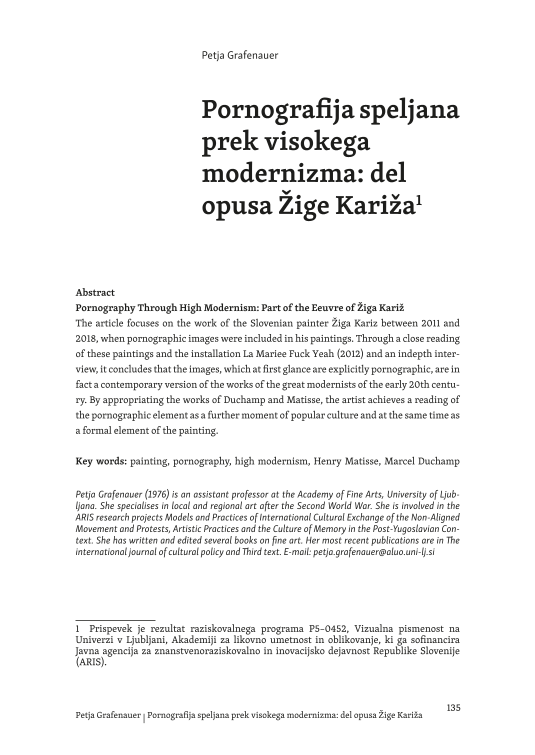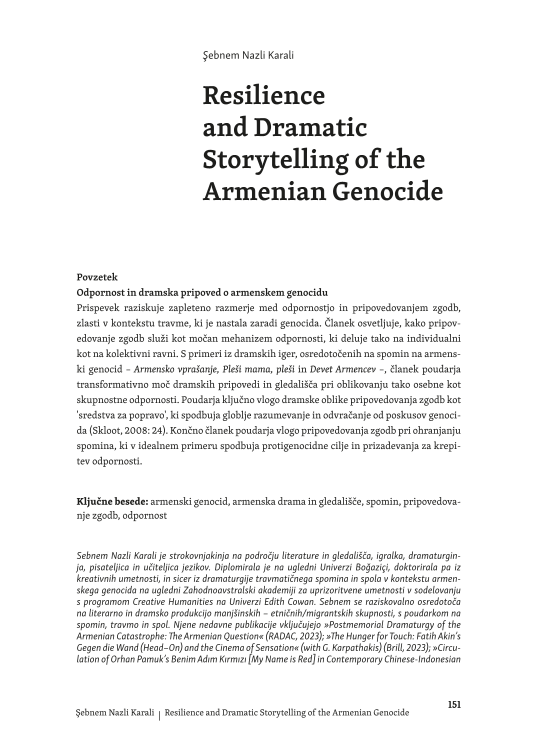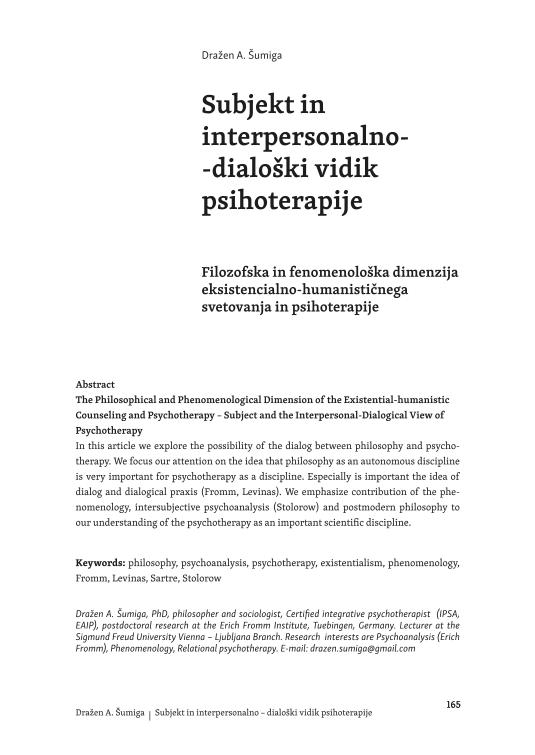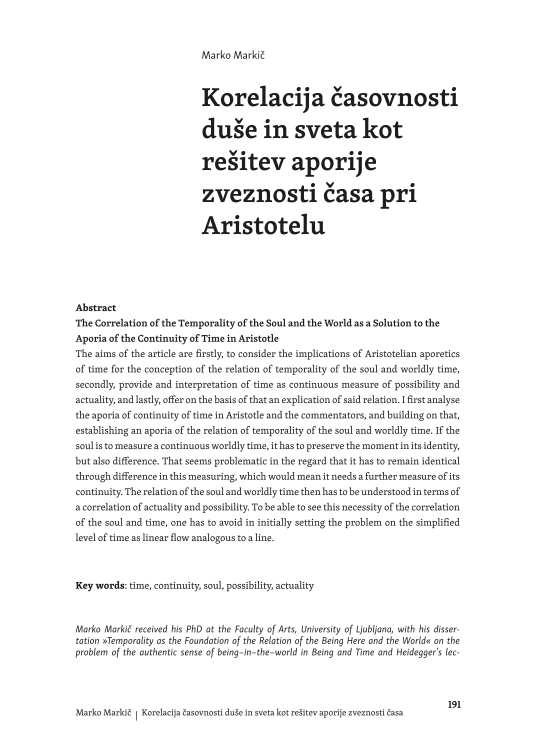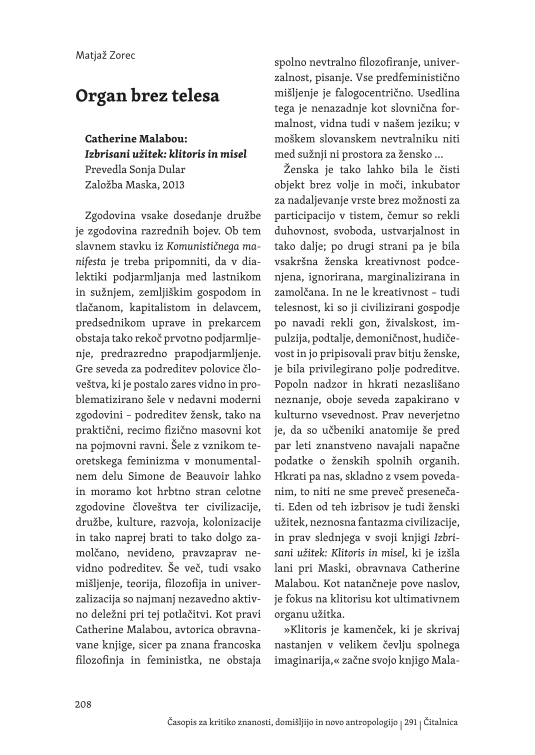Za tematski sklop erotične umetnosti sem se odločila, ker je tematika erotične umetnosti v slovenskem prostoru še vedno precejšnji tabu, zlasti ker so mejniki med nevtralnim, erotičnim in pornografskim v umetnosti pogosto zabrisani in v veliki meri odvisni od konteksta in ker podobna tematika v tej obliki še ni bila naslovljena. Odločila sem se, da bi bilo zanimivo nasloviti tematiko iz različnih zornih kotov od estetskega, ikonografskega, umetnostnoteoretskega, pornografskega, primerjalnega (v kontekstu primerjave med različnimi kulturnimi prostori, kot so Azija, Evropa, Amerika, Afrika ...), zgodovinskega, filozofskega, nevroin psihoestetskega in podobno. Posebno pozornost sem želela nameniti analizi slovenskega prostora, ki po znanih informacijah v kontekstu predlagane teme, razen nekaj diplomskih del in časopisnih člankov, še ni bil sistematično predstavljen. A kaj kmalu se je izkazalo, da sem si zadala precej ambiciozen projekt, in da ne velja zaman za tabuizirano področje, saj mi je od prvotno zastavljenega cilja uspelo pridobiti nekaj tem o sodobni erotični umetnosti in pornografije s poudarkom na slovenskem prostoru, pri čemer slovenski prostor dopolnjujeta še erotična umetnost, kakor je izražena v japonskih lesorezih, in erotična umetnost s poudarkom na ženskem pisanju v času holokavsta na območju bivše Jugoslavije. poudarkom na ženskem pisanju v času holokavsta na območju bivše Jugoslavije.
What is an erotic art? Do all paintings with a sexual theme qualify as erotic? How to distinguish between erotica and erotic art? In what way are aesthetic experiences related to, or different from, erotic experiences and are they at all compatible? Both people and works of art can be sensually appealing, but is the beauty in each case substantially the same property? How helpful is the distinction between the nude and the naked? Can we draw a strict line between erotic art and pornography? We tend to think of art as complex and of pornography as onedimensional, but how clear-cut is that divide? Pornography is often considered harmful, objectifying, and exploitative, but to what extent is erotic art immune to moral criticism of this sort? In addressing such questions this article will provide an overview of current philosophical debates on erotic art. It will also place those debates in historical perspective and, in the closing section, explore some important avenues for future research.
The poets Kristina Hočevar and Majda Kne often tackle erotic lesbian themes in their poetry. This is manifested mainly in viewing, bringing the subject closer to the other and the double and to the final act – the act of love, be it holding hands, a hug, a kiss and, last but not least, sexual intercourse. It is a very direct address, which is like a call or an address to the beloved, to common experiences in making love alone or in public, sometimes you can also find descriptions, very technical lists, impressions of the subject. Love and eroticism are intertwined, as it is not only about physical closeness, but also spirituality and devotion shown by the author in question. At the same time, certain songs can also indicate a distancing, a lack of closeness, and thus the physical and mental withering of the subject.
The article explores the Japanese visual art known as shunga, which primarily developed during the Edo period (1600–1868). Based on the assumption that sexuality cannot be separated from the social and political contexts in which it manifests itself, the article examines the influence of social dynamics on perceptions of sexuality and traces the aesthetic and iconographic motifs originating from China that laid the foundation for the development of Japanese erotic art. Shunga, which translates to »spring picture«, was commercially available during the Edo period and played an important role in the private sphere despite being officially prohibited. The popularity of shunga reveals a particular attitude of the bourgeois society towards sexuality, and the article attempts to define Japanese depictions of explicit sexuality as pornographic art based on various interpretations of the concept of »pornography«.
The text is a contribution to the study of the politics of film representation of the Holocaust regarding the politics of the gendered body. In the discourse on the politics of Holocaust representation within the film media, Zeugin aus der Hölle (Gorke trave), a German film scripted by Yugoslav author Frida Filipović, serves as a case study for a shift from the male gaze to écriture féminine with elements of eroticism. Filipović, a Jewish writer and translator, introduces a unique transmedial discoursive field through her work Gorke trave (Bitter Herbs / Zeugin aus der Hölle / Witness from Hell). Gorke trave (1966–2000) is a unique phenomenon in Yugoslav cinematography and literature. A novelization emerged more than three decades after the film’s creation. The unfinished novel was presented to the public for the first time in the form of a film script, the film Zika Mitrović’s Gorke trave (1966), co-produced by Yugoslavia and West Germany. In the following years, another segment appeared as part of the short story collection Razilaženja / Divergences (1973), and then as a prequel in the romanesque structure of Gorke trave (2000), published at the beginning of the new millennium, and only two years before the author’s death. Within the conceptual framework of écriture féminine, the use of correspondence and fragmented structure are not unusual practices. Detailed examination of the relationships of several media texts that construct the wide discoursive field of Gorke trave highlights the emancipatory potential of women’s transdisciplinary storytelling. The male gaze equates virginity with innocence, thereby erasing the possibility of the previous sexual and erotic encounters for women characters. Conversely, écriture féminine employs the strategy of inscription to build complex woman characters and distinguish between the symbolism of virginity and the concept of innocence, which is of particular significance within the context of the Holocaust. This study reveals the emancipatory potential of transdisciplinary narrative strategies, with an emphasis on multiple marginalized identities, politics of corporeality, women’s sexuality and emotional life as a form of political subjectivisation, and Holocaust testimony in literature. The woman’s lived experience is the focus of realism in the prose of Frida Filipović, which could be seen as transgressive and radically realistic even today. Bodily truth in Gorke trave does not recognize limitations and must be told regardless of the multiple transgressions –within the act of speech itself, resistance to the male gaze, incidental shock effects, and continuous processes of marginalization.
In this article I try to outline the differences between erotica and pornography, and at the same time between the erotic art and pornography. In addition to maintaining and clarifying the difference between erotic art and pornography, I also hope to create a foundation of erotica as something in between eroticism and pornography. I will also show the reasons why we cannot talk about pornographic art, but only about erotic art.
This article examines the contemporary visual matrix involving relations of gender, the body, sexuality and love. We will be interested in the transitions and changes perceived in contemporary times and we will question the relationship between the sexes. The central discussion will focus on the gap between contemporary art, theory and pornography.
The article focuses on the work of the Slovenian painter Žiga Kariz between 2011 and 2018, when pornographic images were included in his paintings. Through a close reading of these paintings and the installation La Mariee Fuck Yeah (2012) and an indepth interview, it concludes that the images, which at first glance are explicitly pornographic, are in fact a contemporary version of the works of the great modernists of the early 20th century. By appropriating the works of Duchamp and Matisse, the artist achieves a reading of the pornographic element as a further moment of popular culture and at the same time as a formal element of the painting.
This article explores the intricate relationship between resilience and storytelling, particularly in the context of genocidal trauma. The article illuminates how storytelling serves as a potent mechanism for resilience, operating on both individual and collective levels. By using examples from plays centred on the memory of the Armenian genocide – The Armenian Question, Dance Mama, Dance, and Nine Armenians – the article underscores the transformative power of dramatic narratives and theatre in shaping personal and communal resilience. It highlights the crucial role of dramatic form of storytelling as an 'agent of repair', fostering deeper understanding and active engagement to discourage genocidal attempts (Skloot, 2008: 24). Ultimately, the study underscores the role of storytelling in preserving memory, ideally advancing antigenocidal objectives and fostering resilience-building endeavours.
In this article we explore the possibility of the dialog between philosophy and psychotherapy. We focus our attention on the idea that philosophy as an autonomous discipline is very important for psychotherapy as a discipline. Especially is important the idea of dialog and dialogical praxis (Fromm, Levinas). We emphasize contribution of the phenomenology, intersubjective psychoanalysis (Stolorow) and postmodern philosophy to our understanding of the psychotherapy as an important scientific discipline.
The aims of the article are firstly, to consider the implications of Aristotelian aporetics of time for the conception of the relation of temporality of the soul and worldly time, secondly, provide and interpretation of time as continuous measure of possibility and actuality, and lastly, offer on the basis of that an explication of said relation. I first analyse the aporia of continuity of time in Aristotle and the commentators, and building on that, establishing an aporia of the relation of temporality of the soul and worldly time. If the soul is to measure a continuous worldly time, it has to preserve the moment in its identity, but also difference. That seems problematic in the regard that it has to remain identical through difference in this measuring, which would mean it needs a further measure of its continuity. The relation of the soul and worldly time then has to be understood in terms of a correlation of actuality and possibility. To be able to see this necessity of the correlation of the soul and time, one has to avoid in initially setting the problem on the simplified level of time as linear flow analogous to a line.
Catherine Malabou, Izbrisani užitek: klitoris in misel. Prevedla Sonja Dular, Založba Maska, 2013
Zgodovina vsake dosedanje družbe je zgodovina razrednih bojev. Ob tem slavnem stavku iz Komunističnega manifesta je treba pripomniti, da v dialektiki podjarmljanja med lastnikom in sužnjem, zemljiškim gospodom in tlačanom, kapitalistom in delavcem, predsednikom uprave in prekarcem obstaja tako rekoč prvotno podjarmljenje, predrazredno prapodjarmljenje. Gre seveda za podreditev polovice človeštva, ki je postalo zares vidno in problematizirano šele v nedavni moderni zgodovini – podreditev žensk, tako na praktični, recimo fizično masovni kot na pojmovni ravni. Šele z vznikom teoretskega feminizma v monumentalnem delu Simone de Beauvoir lahko in moramo kot hrbtno stran celotne zgodovine človeštva ter civilizacije, družbe, kulture, razvoja, kolonizacije in tako naprej brati to tako dolgo zamolčano, nevideno, pravzaprav nevidno podreditev. Še več, tudi vsako mišljenje, teorija, filozofija in univerzalizacija so najmanj nezavedno aktivno deležni pri tej potlačitvi. Kot pravi Catherine Malabou, avtorica obravnavane knjige, sicer pa znana francoska filozofinja in feministka, ne obstaja spolno nevtralno filozofiranje, univerzalnost, pisanje. Vse predfeministično mišljenje je falogocentrično. Usedlina tega je nenazadnje kot slovnična formalnost, vidna tudi v našem jeziku; v moškem slovanskem nevtralniku niti med sužnji ni prostora za žensko …



